Understanding Monopolistic Competition and Oligopoly Market Efficiency
VerifiedAdded on 2023/06/05
|10
|849
|321
Essay
AI Summary
This essay provides a comprehensive overview of monopolistic competition and oligopoly market structures, highlighting their key characteristics, equilibrium conditions, and efficiencies. Monopolistic competition is defined by a large number of firms selling differentiated products, free entry and exit, and some control over price, while oligopoly is characterized by a few dominant firms with interdependent decision-making, barriers to entry, and potential for collusion. The essay discusses short-run and long-run equilibrium in monopolistic competition, as well as competitive and collusive oligopoly models. Both market structures are shown to be allocatively and productively inefficient due to prices being set above marginal cost and underutilization of resources. The conclusion emphasizes that increased internal and foreign competition can mitigate these inefficiencies by forcing firms to become more competitive or exit the market.
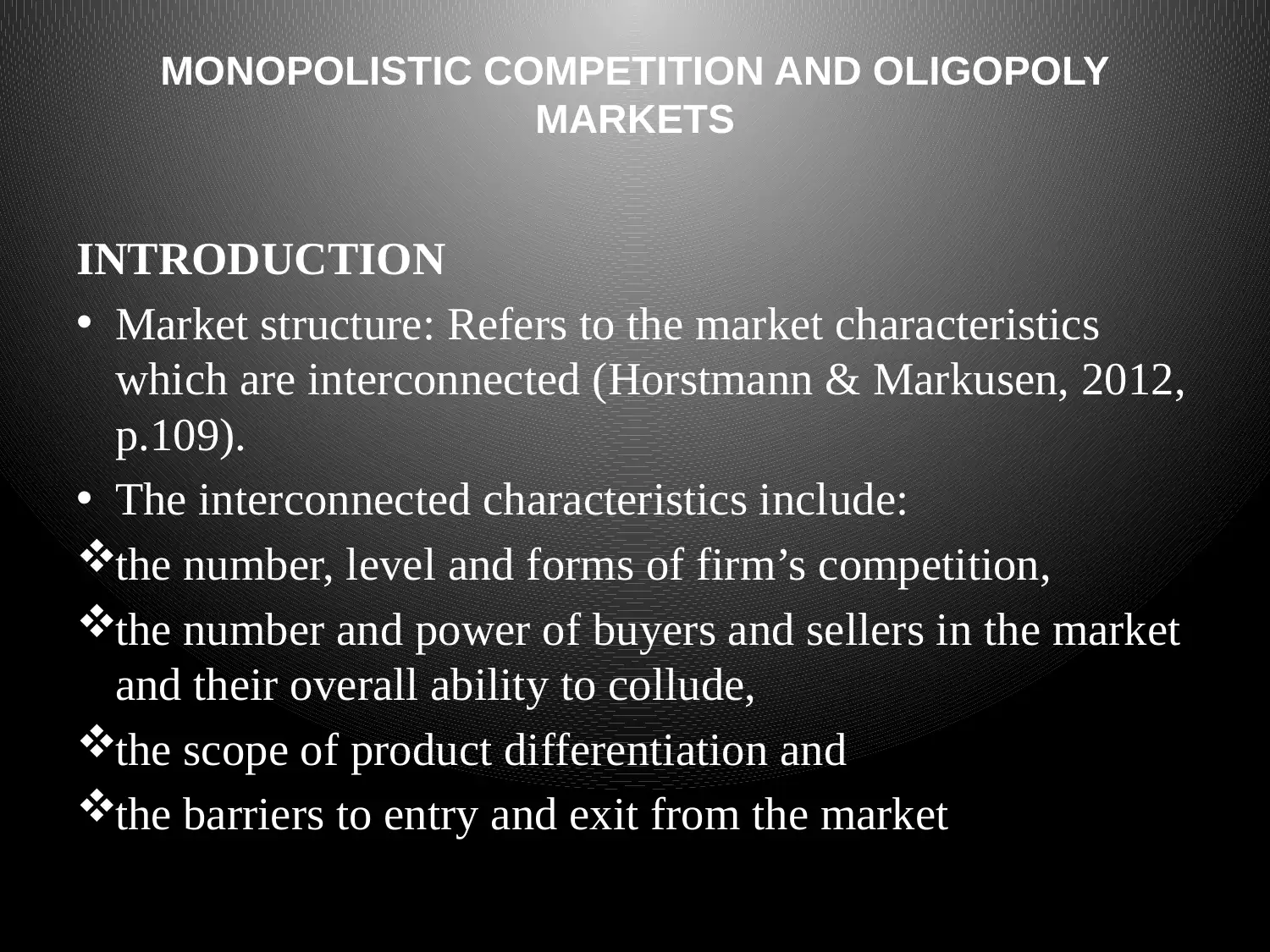
MONOPOLISTIC COMPETITION AND OLIGOPOLY
MARKETS
INTRODUCTION
• Market structure: Refers to the market characteristics
which are interconnected (Horstmann & Markusen, 2012,
p.109).
• The interconnected characteristics include:
the number, level and forms of firm’s competition,
the number and power of buyers and sellers in the market
and their overall ability to collude,
the scope of product differentiation and
the barriers to entry and exit from the market
MARKETS
INTRODUCTION
• Market structure: Refers to the market characteristics
which are interconnected (Horstmann & Markusen, 2012,
p.109).
• The interconnected characteristics include:
the number, level and forms of firm’s competition,
the number and power of buyers and sellers in the market
and their overall ability to collude,
the scope of product differentiation and
the barriers to entry and exit from the market
Paraphrase This Document
Need a fresh take? Get an instant paraphrase of this document with our AI Paraphraser
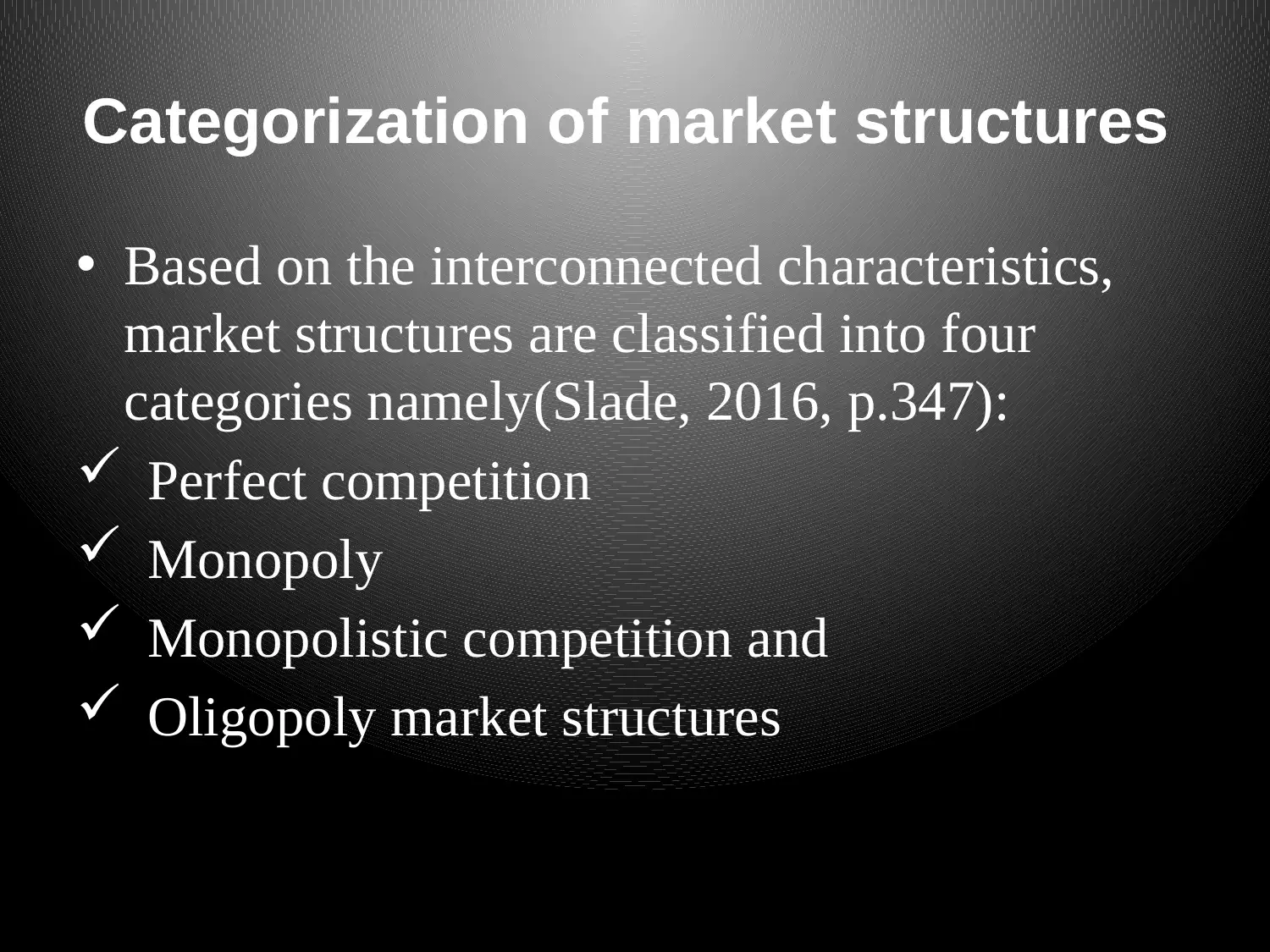
Categorization of market structures
• Based on the interconnected characteristics,
market structures are classified into four
categories namely(Slade, 2016, p.347):
Perfect competition
Monopoly
Monopolistic competition and
Oligopoly market structures
• Based on the interconnected characteristics,
market structures are classified into four
categories namely(Slade, 2016, p.347):
Perfect competition
Monopoly
Monopolistic competition and
Oligopoly market structures
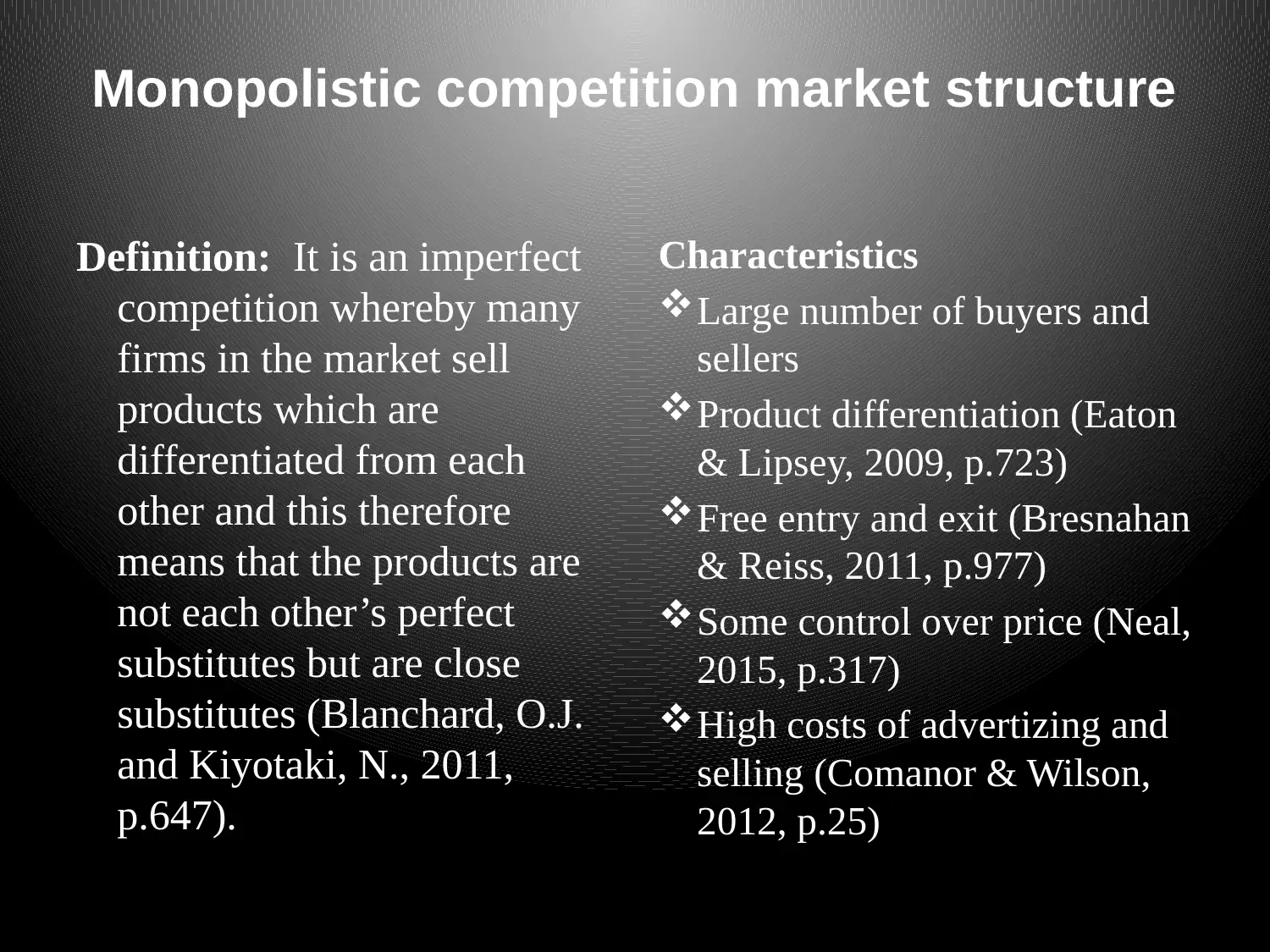
Monopolistic competition market structure
Definition: It is an imperfect
competition whereby many
firms in the market sell
products which are
differentiated from each
other and this therefore
means that the products are
not each other’s perfect
substitutes but are close
substitutes (Blanchard, O.J.
and Kiyotaki, N., 2011,
p.647).
Characteristics
Large number of buyers and
sellers
Product differentiation (Eaton
& Lipsey, 2009, p.723)
Free entry and exit (Bresnahan
& Reiss, 2011, p.977)
Some control over price (Neal,
2015, p.317)
High costs of advertizing and
selling (Comanor & Wilson,
2012, p.25)
Definition: It is an imperfect
competition whereby many
firms in the market sell
products which are
differentiated from each
other and this therefore
means that the products are
not each other’s perfect
substitutes but are close
substitutes (Blanchard, O.J.
and Kiyotaki, N., 2011,
p.647).
Characteristics
Large number of buyers and
sellers
Product differentiation (Eaton
& Lipsey, 2009, p.723)
Free entry and exit (Bresnahan
& Reiss, 2011, p.977)
Some control over price (Neal,
2015, p.317)
High costs of advertizing and
selling (Comanor & Wilson,
2012, p.25)
⊘ This is a preview!⊘
Do you want full access?
Subscribe today to unlock all pages.

Trusted by 1+ million students worldwide
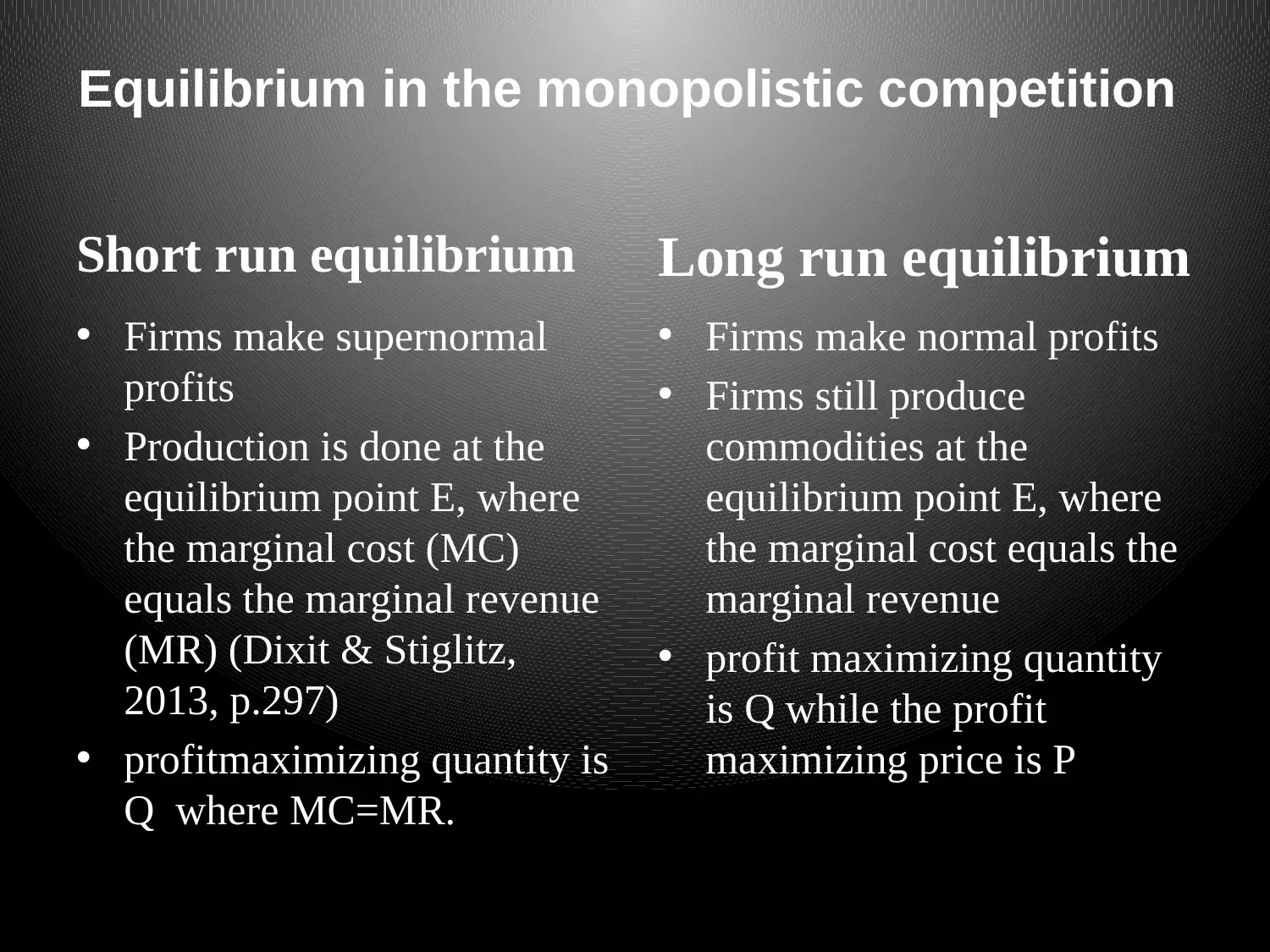
Equilibrium in the monopolistic competition
Short run equilibrium
• Firms make supernormal
profits
• Production is done at the
equilibrium point E, where
the marginal cost (MC)
equals the marginal revenue
(MR) (Dixit & Stiglitz,
2013, p.297)
• profitmaximizing quantity is
Q where MC=MR.
Long run equilibrium
• Firms make normal profits
• Firms still produce
commodities at the
equilibrium point E, where
the marginal cost equals the
marginal revenue
• profit maximizing quantity
is Q while the profit
maximizing price is P
Short run equilibrium
• Firms make supernormal
profits
• Production is done at the
equilibrium point E, where
the marginal cost (MC)
equals the marginal revenue
(MR) (Dixit & Stiglitz,
2013, p.297)
• profitmaximizing quantity is
Q where MC=MR.
Long run equilibrium
• Firms make normal profits
• Firms still produce
commodities at the
equilibrium point E, where
the marginal cost equals the
marginal revenue
• profit maximizing quantity
is Q while the profit
maximizing price is P
Paraphrase This Document
Need a fresh take? Get an instant paraphrase of this document with our AI Paraphraser
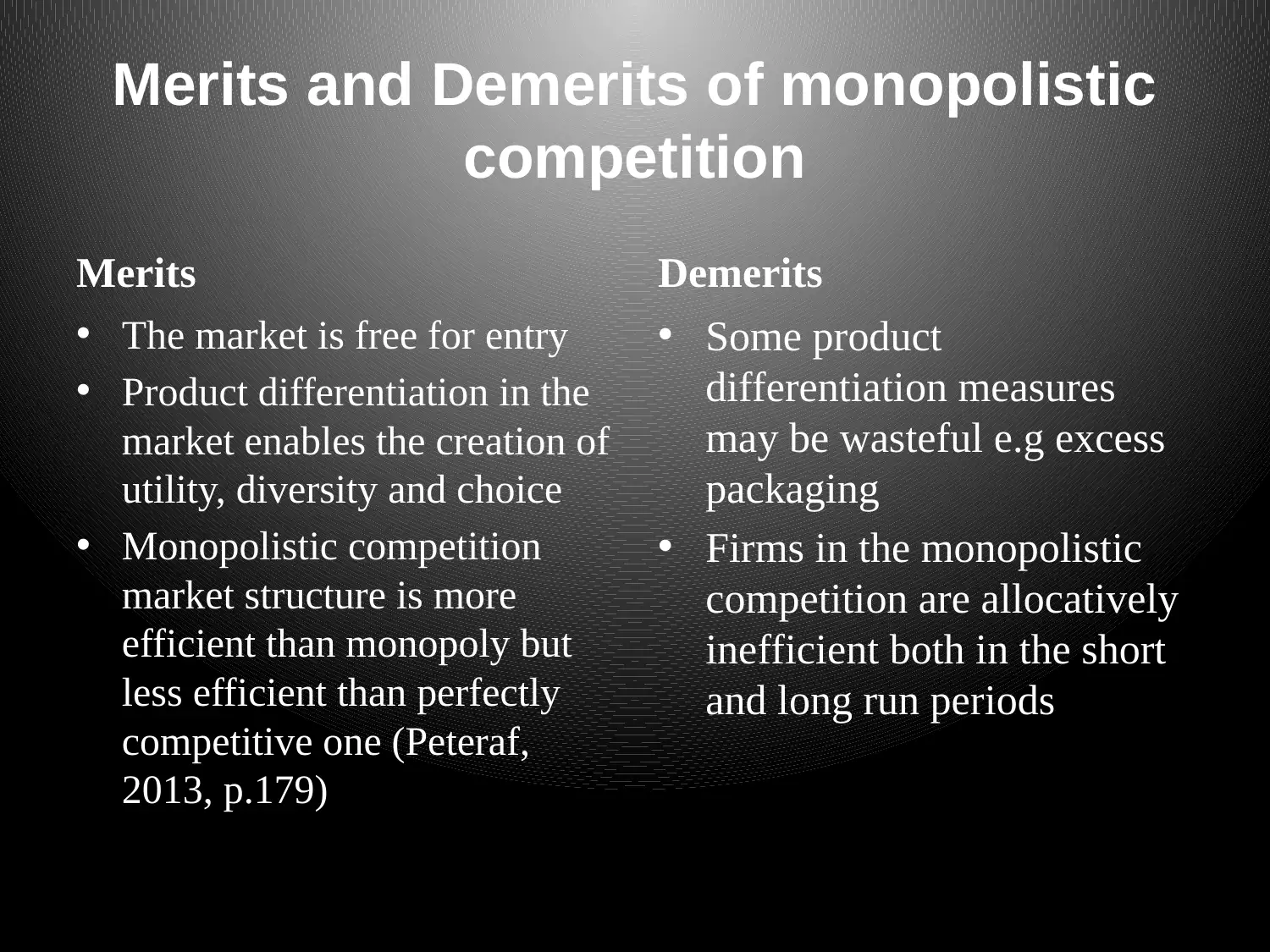
Merits and Demerits of monopolistic
competition
Merits
• The market is free for entry
• Product differentiation in the
market enables the creation of
utility, diversity and choice
• Monopolistic competition
market structure is more
efficient than monopoly but
less efficient than perfectly
competitive one (Peteraf,
2013, p.179)
Demerits
• Some product
differentiation measures
may be wasteful e.g excess
packaging
• Firms in the monopolistic
competition are allocatively
inefficient both in the short
and long run periods
competition
Merits
• The market is free for entry
• Product differentiation in the
market enables the creation of
utility, diversity and choice
• Monopolistic competition
market structure is more
efficient than monopoly but
less efficient than perfectly
competitive one (Peteraf,
2013, p.179)
Demerits
• Some product
differentiation measures
may be wasteful e.g excess
packaging
• Firms in the monopolistic
competition are allocatively
inefficient both in the short
and long run periods

Oligopoly market structure
Definition
• Market structure which is
dominated by only a few
firms that mutually depend
on each other (Brander &
Lewis, 2016, p.956)
Characteristics
Few number of firms
The products are either
homogeneous or
differentiated
Control over price
Barriers to entry (Fee,
Mialon & Williams, 2014,
p.461)
Definition
• Market structure which is
dominated by only a few
firms that mutually depend
on each other (Brander &
Lewis, 2016, p.956)
Characteristics
Few number of firms
The products are either
homogeneous or
differentiated
Control over price
Barriers to entry (Fee,
Mialon & Williams, 2014,
p.461)
⊘ This is a preview!⊘
Do you want full access?
Subscribe today to unlock all pages.

Trusted by 1+ million students worldwide
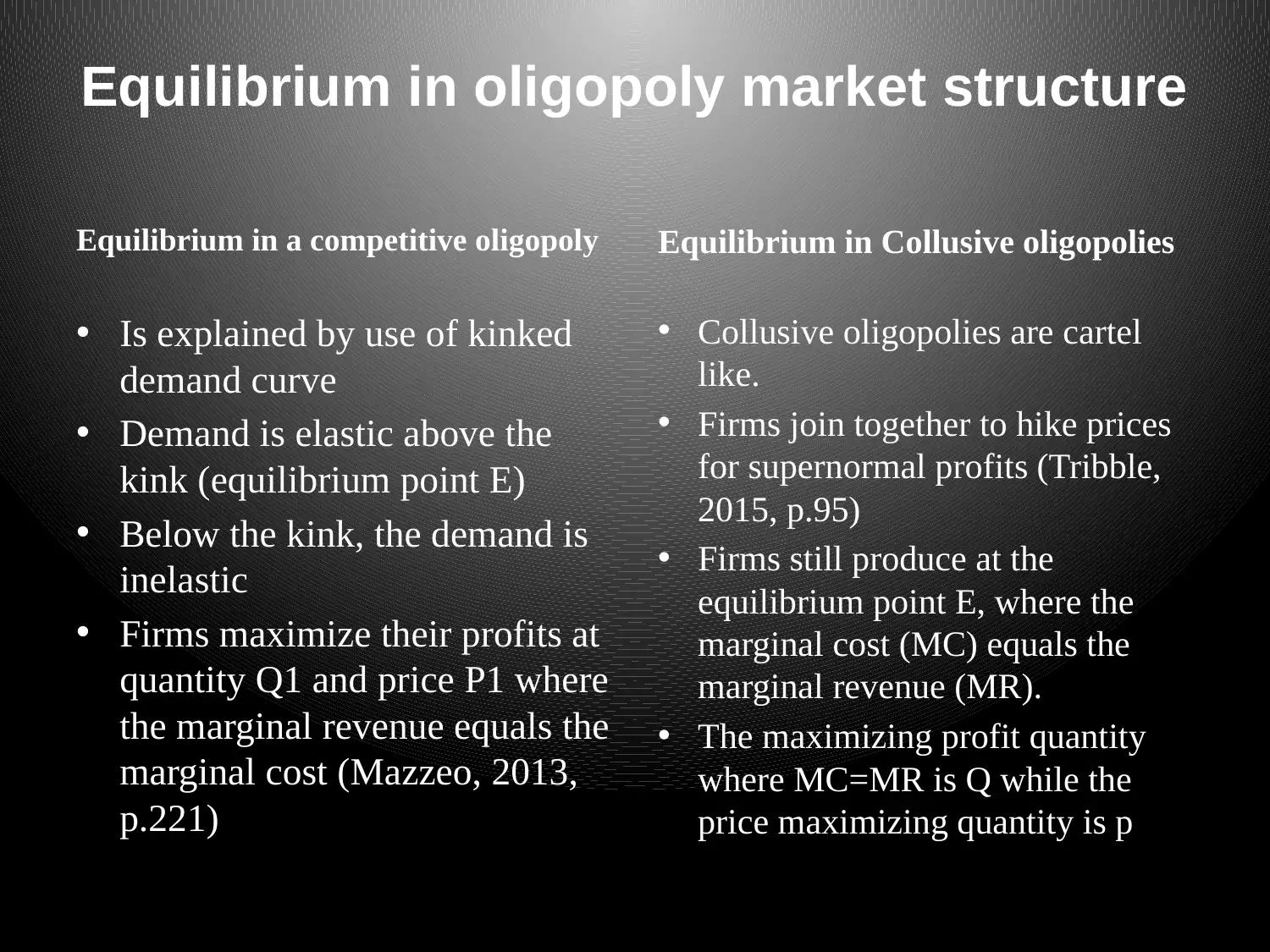
Equilibrium in oligopoly market structure
Equilibrium in a competitive oligopoly
• Is explained by use of kinked
demand curve
• Demand is elastic above the
kink (equilibrium point E)
• Below the kink, the demand is
inelastic
• Firms maximize their profits at
quantity Q1 and price P1 where
the marginal revenue equals the
marginal cost (Mazzeo, 2013,
p.221)
Equilibrium in Collusive oligopolies
• Collusive oligopolies are cartel
like.
• Firms join together to hike prices
for supernormal profits (Tribble,
2015, p.95)
• Firms still produce at the
equilibrium point E, where the
marginal cost (MC) equals the
marginal revenue (MR).
• The maximizing profit quantity
where MC=MR is Q while the
price maximizing quantity is p
Equilibrium in a competitive oligopoly
• Is explained by use of kinked
demand curve
• Demand is elastic above the
kink (equilibrium point E)
• Below the kink, the demand is
inelastic
• Firms maximize their profits at
quantity Q1 and price P1 where
the marginal revenue equals the
marginal cost (Mazzeo, 2013,
p.221)
Equilibrium in Collusive oligopolies
• Collusive oligopolies are cartel
like.
• Firms join together to hike prices
for supernormal profits (Tribble,
2015, p.95)
• Firms still produce at the
equilibrium point E, where the
marginal cost (MC) equals the
marginal revenue (MR).
• The maximizing profit quantity
where MC=MR is Q while the
price maximizing quantity is p
Paraphrase This Document
Need a fresh take? Get an instant paraphrase of this document with our AI Paraphraser

Merits and Demerits of oligopolies
Merits
• Benefits associated with
competitive oligopolies
• Oligopolies are highly
innovative
• Price stability
Demerits
• Disadvantages associated with
collusive oligopolies e.g high
prices
• Oligopolies are inefficient in
terms of resource allocation and
productivity
• Oligopolies involve various
barriers to entry
• Oligopolies mat be associated
with high concentration and this
minimizes the consumer choice
Merits
• Benefits associated with
competitive oligopolies
• Oligopolies are highly
innovative
• Price stability
Demerits
• Disadvantages associated with
collusive oligopolies e.g high
prices
• Oligopolies are inefficient in
terms of resource allocation and
productivity
• Oligopolies involve various
barriers to entry
• Oligopolies mat be associated
with high concentration and this
minimizes the consumer choice

Efficiency in monopolistic competition and
oligopoly markets
Efficiency in monopolistic competition
• Both allocative and
productive inefficiency
• Prices are set high above the
marginal cost
• Underutilization of available
resources leading to
underproduction and hence
excess capacity to produce
Efficiency in oligopoly markets
• Both allocative and
productive inefficiency
• Prices are set high above the
marginal cost
• Underutilization of available
resources leading to
underproduction and hence
excess capacity to produce
oligopoly markets
Efficiency in monopolistic competition
• Both allocative and
productive inefficiency
• Prices are set high above the
marginal cost
• Underutilization of available
resources leading to
underproduction and hence
excess capacity to produce
Efficiency in oligopoly markets
• Both allocative and
productive inefficiency
• Prices are set high above the
marginal cost
• Underutilization of available
resources leading to
underproduction and hence
excess capacity to produce
⊘ This is a preview!⊘
Do you want full access?
Subscribe today to unlock all pages.

Trusted by 1+ million students worldwide
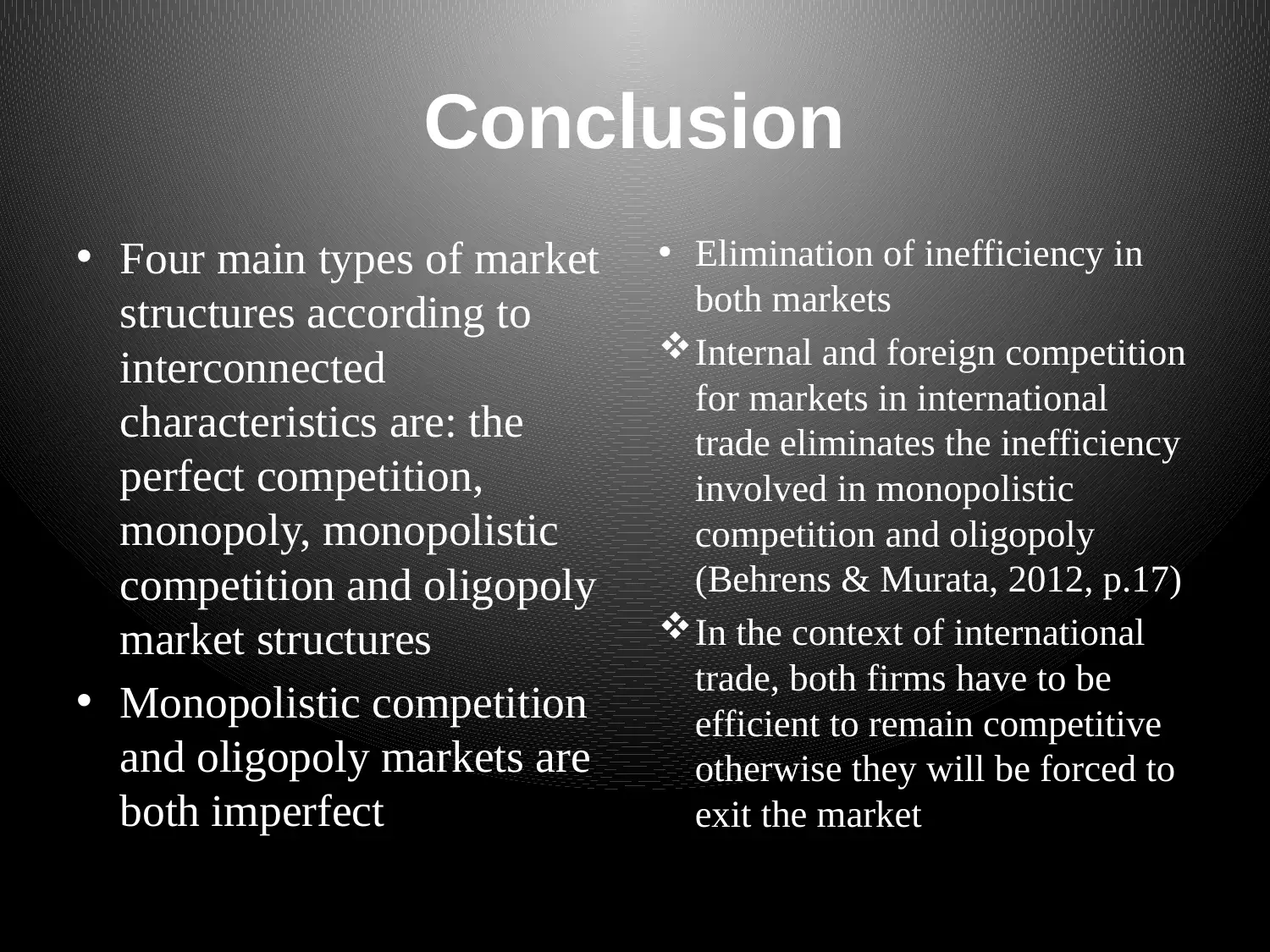
Conclusion
• Four main types of market
structures according to
interconnected
characteristics are: the
perfect competition,
monopoly, monopolistic
competition and oligopoly
market structures
• Monopolistic competition
and oligopoly markets are
both imperfect
• Elimination of inefficiency in
both markets
Internal and foreign competition
for markets in international
trade eliminates the inefficiency
involved in monopolistic
competition and oligopoly
(Behrens & Murata, 2012, p.17)
In the context of international
trade, both firms have to be
efficient to remain competitive
otherwise they will be forced to
exit the market
• Four main types of market
structures according to
interconnected
characteristics are: the
perfect competition,
monopoly, monopolistic
competition and oligopoly
market structures
• Monopolistic competition
and oligopoly markets are
both imperfect
• Elimination of inefficiency in
both markets
Internal and foreign competition
for markets in international
trade eliminates the inefficiency
involved in monopolistic
competition and oligopoly
(Behrens & Murata, 2012, p.17)
In the context of international
trade, both firms have to be
efficient to remain competitive
otherwise they will be forced to
exit the market
1 out of 10
Related Documents
Your All-in-One AI-Powered Toolkit for Academic Success.
+13062052269
info@desklib.com
Available 24*7 on WhatsApp / Email
![[object Object]](/_next/static/media/star-bottom.7253800d.svg)
Unlock your academic potential
Copyright © 2020–2025 A2Z Services. All Rights Reserved. Developed and managed by ZUCOL.



